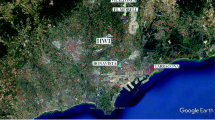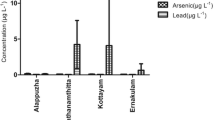Abstract
Human beings working or living near an industrial site where toxic chemicals such as As, Hg, Cd, Cu, Mn, Pb, Zn and or their compounds are used or indiscriminately discharged into the environment, are constantly exposed to such chemicals via ingestion (drinking or eating), dermal contact or inhalation (breathing). However, in developing countries such as Ghana, limited data on levels of the aforementioned chemicals in whole blood and serum of human beings as a result of exposure to the aforementioned chemicals from mining communities and non-mining communities is preventing effective policy formulation to protect human health. Hence, this study was undertaken to measure the levels of the aforementioned toxic chemicals in whole blood and serum of 300 resident adults from mining (Tarkwa Nsuaem Municipality Assembly (TNMA) and Prestea Huni Valley District (PHVD)) and non-mining (Cape Coast Metropolis) communities in Ghana, using neutron activation analysis (NAA). Blood samples were taken from 200 resident adults (105 males and 95 females) from mining and 100 resident adults (60 males and 40 males) from non-mining communities in the study area following the completion of an informed consent and the issuance of ethical clearance by the Ghana Health Service Ethical Committee. The mean concentrations for As, Hg, Cd, Cu, Mn, Pb and Zn in whole blood of residents from mining communities were as follows: 38 ± 320 μg/L, 63 ± 0.23 μg/L, 303 ± 117 μg/L, 3300 ± 953, 195 ± 90 μg/L, 28 ± 14 μg/L and 1405 ± 458 μg/L, respectively; while the levels of measured toxic chemicals in the serum of resident adults from mining communities were as follows: 65 ± 14 μg/L, 358 ± 22 μg/l, 134 ± 12 μg/L, 3590 ± 254 μg/L, 401 ± 113 μg/L, 58 ± 5.8 μg/L and 49 ± 31 μg/L, respectively, for As, Hg, Cd, Cu, Mn, Pb and Zn and were found to have exceeded the permissible WHO guideline values.

Similar content being viewed by others
References
Amegbey NA, Adimado AA (2003) Impacts of cyanide spillages in Ghana. Miner Process Ext Metall 112(1):126–131
American Water Works Association (AWWA) (1998) Standard methods for the examination of waste water. Washington, DC
Arbuckle TE (2006) Are there sex and gender differences in acute exposures to chemicals in the same setting? Environ Res 101:195–204
Avotri TSM, Amegbey NA, Sandow MA, Forson SAK (2002) The health impact of cyanide spillage at Goldfields Ghana Limited, Tarkwa: Funded by Goldfields Ghana Limited (GFGL). Unpublished
Batariova A, Spevackova BB, Cejchanova M, Smid J, Cerna M (2006) Blood and urine levels of Pb. Cd and Hg in the general population of the Czech Republic and proposed reference values. Int J Hyg Environ Health 209:359–366
Centre for Disease Control Prevention (2011) Unweighted response rates for NHANES 2007–2008 by Age and Gender. Available from: http://www.cdc.gov/nchs/data/nhanes/response-rates-cps/RRT0708MF.pdf Accessed March 3, 2015
Gonalez-Estecha M, Trasobares E, Fuentes M, Martinez JM, Cano S, Vergara N, Gaspar MJ, Gonalez-Revalderia J, Barciela MC, Bugarin Z, Fernandez MD, Pilar Badia P, Bermejo P, Fernandez C, Arroyo M (2010) Blood lead and cadmium in a six hospital employee population. PESA study, 2009. J Trace Elem Med Biol. doi:10.1016/j.jtemb.2010.10.004
IPCS (2000) Human exposure assessment. World Health Organization, International Programme on Chemical Safety (Environmental Health Criteria 212), Geneva
IPCS (2001) Biomarkers in risk assessment. Validity and validation. World Health Organization, International Programme on Chemical Safety (Environmental Health Criteria 222), Geneva.
Jakubowski M, Trizcinka–Ochocka M, Razniewska G, Christensen JM, Starek A (1996) Blood lead in the general population in Poland. Int Arch Occup Environ Health 68:193–198
Lauwerys RR, Hoet P (1993) Industrial chemical exposure: guidelines for biological monitoring, 2nd edn. Lewis Publishers, Boca Raton, pp 32–38
Lavi N, Alfassi ZB (1990) Determination of trace amounts of cadmium, cobalt, chromium, iron, molybdenum, nickel, selenium, titanium, and zinc in blood and milk by neutron activation analysis. Analyst 115:817–822
Mergler D, Huel G, Bowler R, Iregren A, Belanger S, Baldwin M (1994) Nervous systems dysfunction among workers with long-term exposure to manganese. Environ Res 64:151–180
Nixon DE, Moyer TP (1996) Routine clinical determination of lead, arsenic, cadmium, and thallium in urine and whole blood by inductive couple plasma mass spectrophotometry. Spectrochim Acta B 51(1):13
Obiri S, Dodoo KD, Armah FA, Essuman DK, Cobbina SJ (2010a) Evaluation of lead and mercury neurotoxic health risk by resident children in the Obuasi Municipality, Ghana. Environ Toxicol Pharmacol 29:209–212
Obiri S, Dodoo DK, Essumang DK, Armah FA (2010b) Cancer and non-cancer risk assessment from exposure to arsenic, cadmium and copper by resident adults and children in the Obuasi Municipality, Ghana. Int J Human Ecol Risk Assess 160:651–658
Porta M, Puigdomenech E, Gari E, de Basea MB, Guillen M, Lopez T, Bigas E, Pumarega J, Llebaria X, Grimalt JO, Tresserras R (2010) Distribution of blood concentrations of persistent organic pollutants in representative sample of the population of Catalonia. Environ Int 36:655–664
Rawlings DE, Dew D, du Plessis C (2003) Biomineralization of metal-containing ores and concentrates. Trends Biotechnol 21(1):38–44
Rodriguez-Agudelo Y, Riojas-Rodriguez H, Rios C, Rosas I, Sabido E, Miranda J (2006) Motor alterations associated to environmental exposure to manganese in Mexico. Sci Total Environ 368:542–556
Satarug S, Garret SH, Sens MA, Sens DA (2010) Cadmium, environmental exposure, and health outcomes. Environ Health Perspect 118:182–190
Schuhmacher M, Domingo JL, Corbella J (1994) Zinc and copper levels in serum and urine: relationship to biological, habitual and environmental factors. Sci Total Environ 148:67–72
Seifert B, Becker K, Krause C, Schulz C (2000) The German environmental survey 1990/1992 (GerES II): a representative population study. J Expo Anal Environ Epidemiol 10:103–114
USEPA (1997) Exposure factor handbook. NCEA-W-005. Office of Research and Development, Washington, DC
Vahter M, Akesson A, Liden C, Ceccatell S, Berglund M (2007) Gender differences in the deposition and toxicity of metals. Environ Res 104:85–95
Wilhelm M, Ewers U, Schulz C (2004) Revised and new reference values for some traces elements in blood and urine for human biomonitoring in environmental medicine. Int J Hyg Environ Health 207:69–73
World Health Organization (WHO) (2007) Health risks of heavy metals from long-range transboundary air pollution. WHO, Denmark
Acknowledgments
This work was supported by a research grant from the Centre for Environmental Impact Analysis Research Foundation.
Author information
Authors and Affiliations
Corresponding author
Ethics declarations
Informed consent was obtained from the participants and ethical clearance by the Ghana Health Service Ethical Committee was issued. The authors further disclose no conflict of interest
Additional information
Responsible editor: Philippe Garrigues
Rights and permissions
About this article
Cite this article
Obiri, S., Yeboah, P.O., Osae, S. et al. Levels of arsenic, mercury, cadmium, copper, lead, zinc and manganese in serum and whole blood of resident adults from mining and non-mining communities in Ghana. Environ Sci Pollut Res 23, 16589–16597 (2016). https://doi.org/10.1007/s11356-016-6537-0
Received:
Accepted:
Published:
Issue Date:
DOI: https://doi.org/10.1007/s11356-016-6537-0




